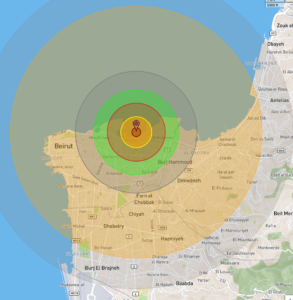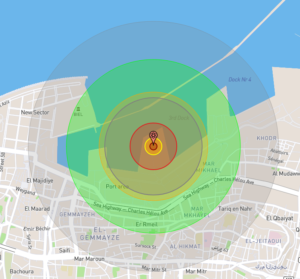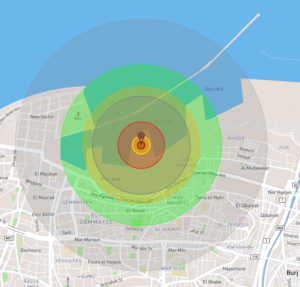Yesterday a massive explosion ripped through Beirut, Lebanon from the city’s port:
Here’s a video of the aftermath:
Sometimes you do calculations and get a result that you know must be wrong, and you report them anyway so others can spot your errors. Reports had the explosion shattering windows 10 kilometers away, and doing damage to the Beirut airport, so I set out to calculate the explosive yield using the Nukemap, based on shattering windows at the airport (the 1 psi overpressure ring) and ignoring radiation effects. (The nukemap interface is far more user friendly than the “Nuclear bomb Effects Computer” at the back of Samuel Glasstone’s The Effects of Nuclear Weapons.)
Here’s the map with the resulting 1 psi ring just reaching the airport:

That’s a blast effect map for a 300 kiloton blast.
That has to be wrong, since the devastation is nowhere near that immense, and I can’t fathom even having enough space to store that much ANFO or PETN in one location. (And it was obviously a non-nuclear blast, due to lack of radiation and the color of the blast itself.)
So let’s look at some comparable explosions:
It’s reported that the port is under unofficial Hazbollah control, and wide-spread rumor is that it was a Hezbollah munitions or rocket factory that went up, but I haven’t seen any confirmation of this.
In the fire before the big explosion, fireworks or munitions are clearly seen going off.
The speed of the blast makes me think it was not TNT or a BLEVE. That explosion went up fast, and all at once. Here’s a Tweeter that suggests it was ammonia nitrate:
CHEMISTRY FACT: Explosives have characteristic "detonation velocities" at which shockwaves expand. Smartphone video records at 30 FPS, so the adjacent frames here suggest the front expands at ~100 m/(1/30 sec), or 3,000 m/sec. Consistent with ammonium nitrate, not black powder. pic.twitter.com/DDoVJxY3gP
— Quantian (@quantian1) August 4, 2020
And indeed that’s what the government has come out to say it is:
BREAKING: Lebanese Prime Minister says #Beirut explosions caused by an estimated 2,750 tons of ammonium nitrate left unsecured for 6 years in a warehouse. He vows to punish officials responsible. 50+ dead, 3,000 injured, hospitals overwhelmed.
— Bill Neely (@BillNeelyNBC) August 4, 2020
Current death toll is over 100.
But how do you abandon 2,750 tons of ammonium nitrate? I know Lebanon is not exactly run on western efficiency, but that much exploding stuff just lying around for six years does rather strain credibility.
But to return to the title question: ammonium nitrate is roughly 42% as effective as TNT. Which means the explosion would have been about 1.155 kilotons, or less than 1/15th the power of the atomic bomb dropped on Hiroshima. Assuming that’s correct, here’s the revised nukemap blast:

Somehow that blast radius seems too small, as the damage and overpressure wave seemed to travel much farther than shown here. But you wouldn’t want to stand next to it.
I wrote Lebanon expert Michael Totten to ask about the blast, and he said he heard that the Lebanese Army has been storing confiscated high explosives there since 2014. If we assume that it’s ANFO rather than straight ammonium nitrate, that’s about 72% as effective as TNT, and with just under twice the detonation velocity of ammonium nitrate. That yields a blast of 1.98 kilotons. The nukemap for that:

That seems to accord a bit better with blast observations.
(Hat tip: Dwight and RoadRich.)
Tags: ammonium nitrate, Beirut, explosion, Foreign Policy, Hezbollah, Lebanon, video
Could this have been a Hezbollah munitions warehouse?
RDX is the active ingredient in C4. HMX is often used in solid rocket motors. I saw one comment claim these can leave a red-orange cloud in their wake.
C-4 is made with RDX and PETN. Semtex, the east block plastic explosive is made of PETN.
Ammonium nitrate plus stuff made from potassium nitrate equals a really big boom!